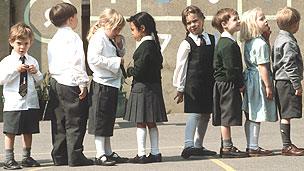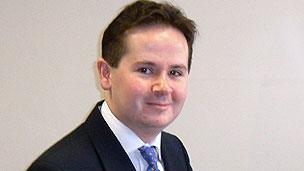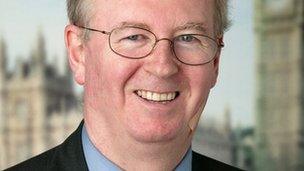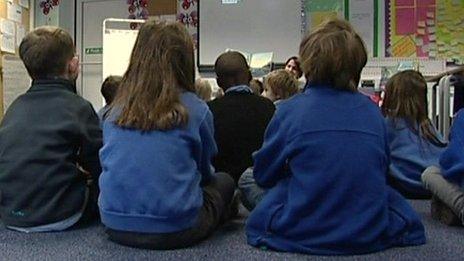Primary schools to rise to 1,000 pupils in places shortage
- Published

There are 5,500 fewer primary schools than the last time the primary population was this size
A growing number of primary schools will have 1,000 pupils or more - as extra classes are added to cope with a rapid increase in the birth rate.
Instead of one or two classes in each year group, there are plans for some schools to have six forms in each year.
The Local Government Association says councils would "step up to the plate" to ensure enough primary places.
The Department for Education says it is providing £4bn for areas "facing the greatest pressure".
It is also relaxing building regulations so that new schools can occupy a smaller space - secondary schools by 15% and primary schools by 5% - but the DfE says this has nothing to do with the shortage of places.
Supersize schools
The rise of supersize primary schools reflects urgent efforts to find places for the surging numbers of pupils - with official figures showing that an extra 455,000 places will be needed in England by 2015.

The LGA's David Simmonds says bigger schools are going to increase
If expansion proposals are implemented it would mean Birmingham, Brent, Waltham Forest, Newham, Redbridge, Hillingdon, Bromley and Barking could all have examples of primary schools with capacity for about 1,000 pupils and in some cases up to 1,200.
There are many more schools which will be expanded to take 90 or 120 pupils in each year, with proposals for some schools to double their intakes.
Brent Council, in north London, has published a report showing it will need another 23 classrooms.
It already has more than 500 primary age children which are not placed in any school - enough to fill a traditional size school.
An earlier report included a shortlist of four primary schools which would have capacity for more than 1,000 pupils by 2014-15.
A spokesman said Brent Council was doing "absolutely everything it can, working closely with local schools, to create more spaces... but it is a real challenge".
Spikes in population
Earlier this week, John Howson, a research fellow at Oxford University's education department, described the shortage of primary places as the "biggest problem" facing the school system.
The shortage is not only in the biggest cities - there are pressures in places such as Winchester, Bristol and Bournemouth.
But compounding the challenge is that the pattern of population growth is very uneven - with a surplus of places in some parts of the country.
There are even big differences within cities. In Birmingham, the birth rate rose by 25% between 2000 and 2007.
But within this average, there are wards with a primary-age population projected to rise by more than 50% and others where there is zero increase expected.
In response to such local pressures, there are plans for Nansen Primary in Birmingham to expand from 630 pupils to 1,260 - which means moving to six forms per year group.
There have been many different local proposals to finding enough space for extra pupils - including temporary classrooms, converting empty shops, developing split-site schools and in Barking there was a suggestion for pupils using a building in different shifts.
Parental choice
But it is also putting pressure on parental choice.
In response, Tower Hamlets in east London is considering changes to its admissions policy for next year, including a system which would recognise how far children would have to travel to their next available place if local schools were full up.
It also means a distinct change in the image of a typical primary school.

This is the biggest challenge facing the school system, says John Howson, Oxford University research fellow
Between 1950 and 2010, the average size of a primary school in the UK remained relatively constant, in a narrow range between 180 and 220 pupils.
There were also 5,500 more primary schools in the early 1970s, when there was last such a demand for places.
David Simmonds, chairman of the LGA's Children and Young People Board, says much bigger primary schools are now going to become "less unusual".
But Mr Simmonds, deputy leader of Hillingdon Council, is confident that local authorities will be able to cope with the pressure.
The decision to expand existing schools in urban areas, where land is scarce and expensive, is often the most practical way of creating more places, he says. In rural and suburban areas, there might be more opportunity for new schools.
The response of parents can vary, he says, in what is an "emotive" subject.
Big is beautiful?
Parents wanting to get children into an oversubscribed school might welcome the creation of more places - while those at the school might be less enthusiastic about such major changes to pupil numbers.
There can also be practical questions such as parking congestion around schools, he says.
The response from parents to previous stories on the BBC News website also shows that there are supporters of bigger schools - with emails arguing that they provide the capacity for more activities, sports and specialist staff.
Head teachers' leader Russell Hobby backed the expansion of existing schools as the best response to the places shortage.
"However, there are limits to how far a primary can grow and still retain the ethos that makes it special and welcoming to young children. Primary heads are more than capable of handing the logistics, but it is the culture and pastoral care that are at issue," said Mr Hobby, leader of the National Association of Head Teachers.
"Primaries can run well at 500 or even 700 pupils, but then you're stretching it."
The shortage of primary places also runs across political fault lines.
Local authorities have a responsibility to ensure enough places - but the government has a "presumption" that new schools should be free schools or academies, outside of local authority control.
This has raised questions about whether the political investment in free schools is at odds with the strategic need to meet the demand for places.
Mr Simmonds, a Conservative, says councils should work with potential free school providers and that there should not be any delays as a result.
But he says it is clear that tackling this places shortage is going to be a priority.
"For the next five years, almost all the capital spending will be on primary places," he said.
A spokesman for the Department for Education said: "We're creating thousands more places to deal with the impact of soaring birth rates on primary schools. We're more than doubling targeted investment at areas facing the greatest pressure on numbers - over £4billion in the next four years.
"No-one is saying it will be easy balancing demand for places with retaining the sort of character and ethos that parents want. Our job is to put the capital and the policies to help councils and schools to make the right decisions."
- Published14 February 2012

- Published10 January 2012







